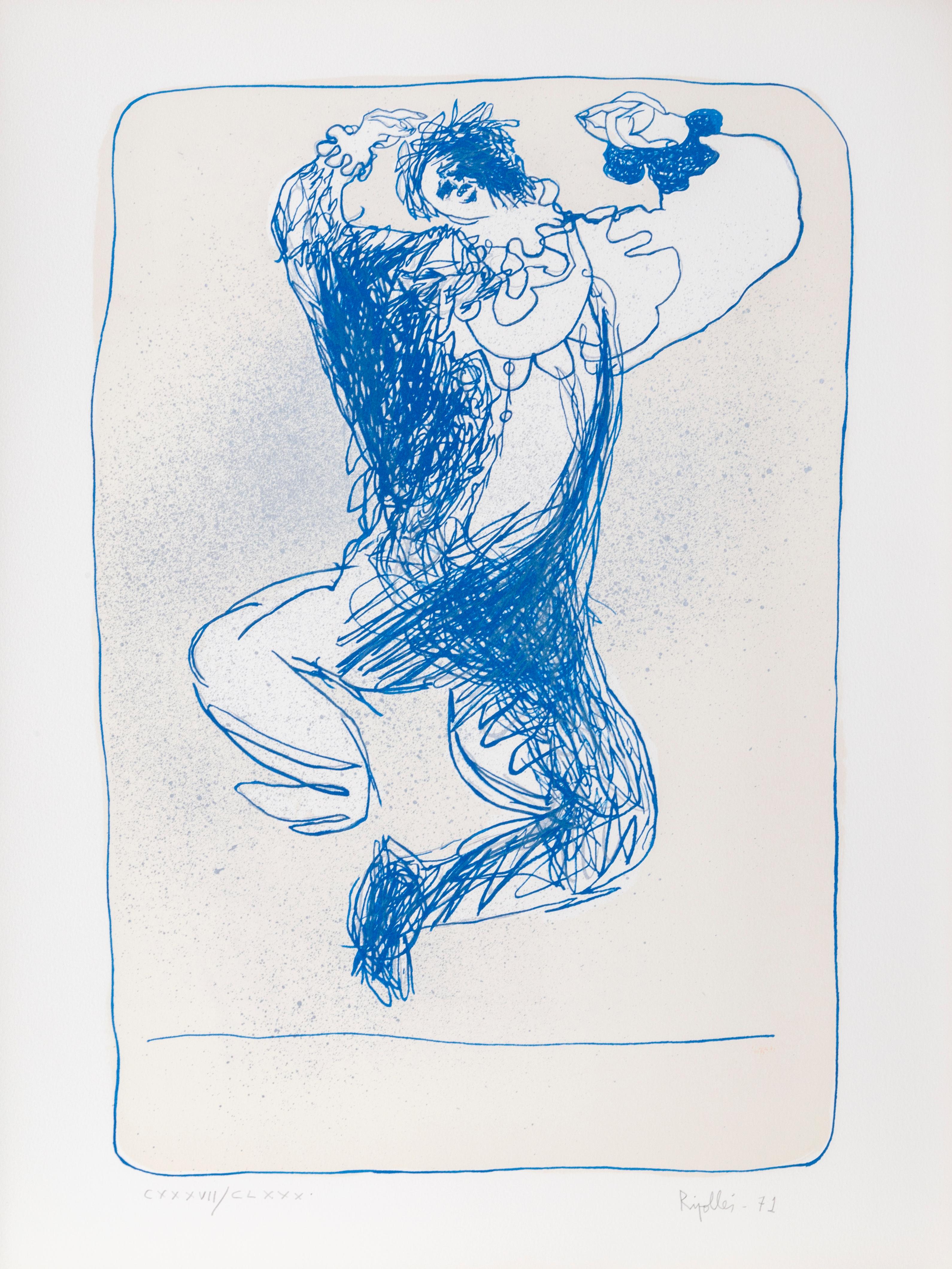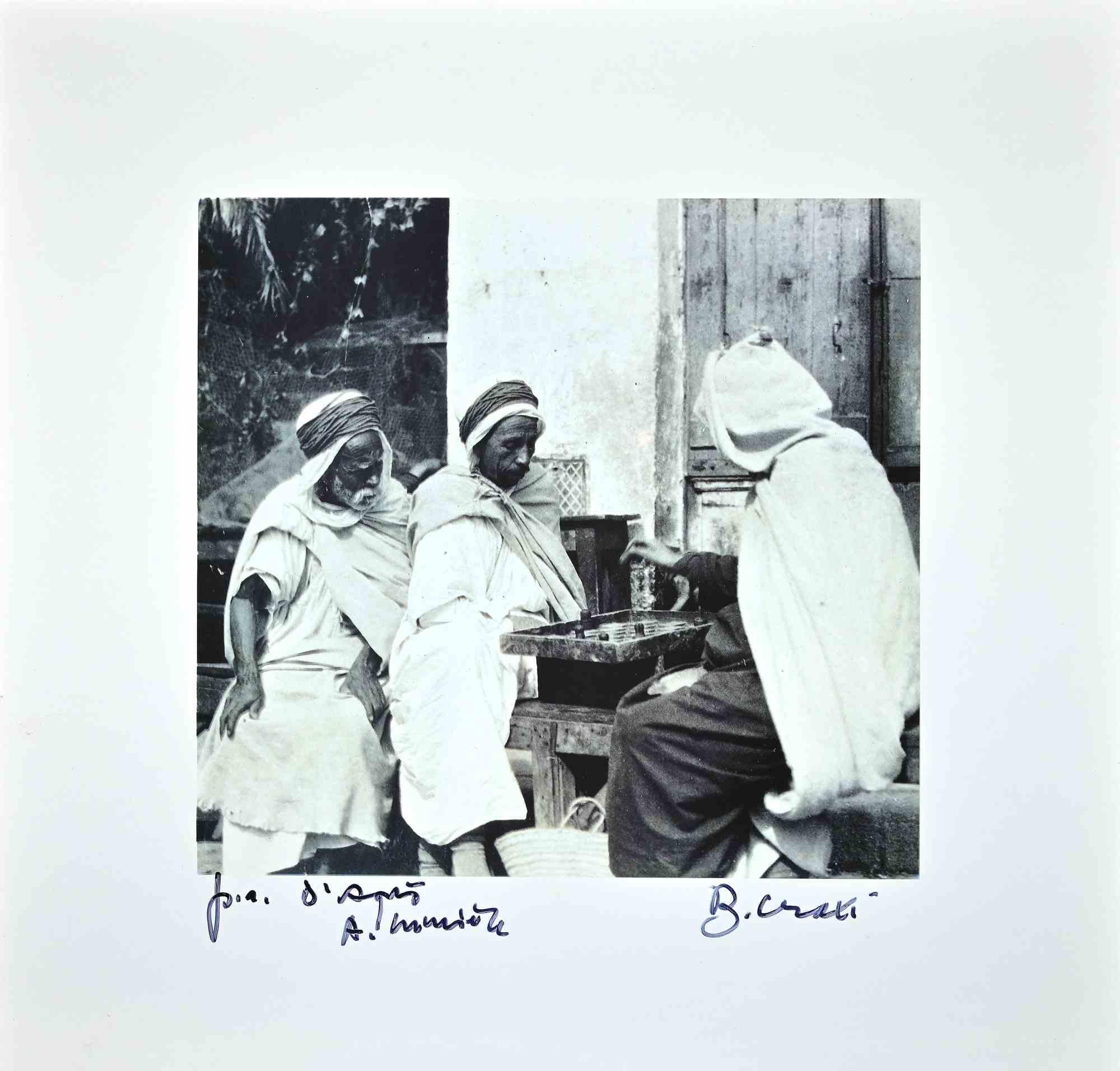Marc Chagall"Carte de Voeux (New Year Greeting Card), " Original Lithograph by Marc Chagall1980
1980
About the Item
- Creator:Marc Chagall (1887 - 1985, French)
- Creation Year:1980
- Dimensions:Height: 13.875 in (35.25 cm)Width: 11.875 in (30.17 cm)
- Medium:
- Movement & Style:
- Period:
- Condition:
- Gallery Location:Milwaukee, WI
- Reference Number:
Marc Chagall
Described by art critic Robert Hughes as "the quintessential Jewish artist of the twentieth century," the Russian-French modernist Marc Chagall worked in nearly every artistic medium. Influenced by Symbolism, Fauvism, Cubism and Surrealism, he developed his own distinctive style, combining avant-garde techniques and motifs with elements drawn from Eastern European Jewish folk art.
Born Moishe Segal in 1887, in Belarus (then part of the Russian empire), Chagall is often celebrated for his figurative paintings, but he also produced stained-glass windows for the cathedrals of Reims and Metz, in France; for the United Nations, in New York; and for the Hadassah Hospital in Jerusalem, as well as book illustrations, stage sets, ceramics, tapestries and fine-art prints. Characterized by a bold color palette and whimsical imagery, his works are often narrative, depicting small-village scenes and quotidian moments of peasant life, as in his late painting The Flight into Egypt from 1980.
Before World War I, Chagall traveled between St. Petersburg, Paris and Berlin. When the conflict broke out, he returned to Soviet-occupied Belarus, where he founded the Vitebsk Arts College before leaving again for Paris in 1922. He fled to the United States during World War II but in 1947 returned to France, where he spent the rest of his life. His peripatetic career left its mark on his style, which was distinctly international, incorporating elements from each of the cultures he experienced.
Marc Chagall remains one of the past century’s most respected talents — find his art on 1stDibs.
- ShippingRetrieving quote...Ships From: Milwaukee, WI
- Return PolicyA return for this item may be initiated within 14 days of delivery.
- "7Eme Bal de l'AAAA Skater, " Original Lithograph Poster by Ludovic Rodo PissarrBy Ludovic-Rodo PissarroLocated in Milwaukee, WI"7Eme Bal de l'AAAA Skater" is an original color lithograph poster by Ludovic Rodo Pissarro. The artist signed the piece in plate lower right. It depicts a wo...Category
1920s Modern Figurative Prints
MaterialsLithograph
- "Boy With Book Looking Out Window, " Original Lithograph print classic giftBy James Ormsbee ChapinLocated in Milwaukee, WI"Boy With Book Looking Out Window" is an original lithograph print by James Ormsbee Chapin. The artist signed the piece in pencil lower right. This piece depicts a boy looking out th...Category
1940s Modern Figurative Prints
MaterialsLithograph
- Late 19th century lithograph nude figures faces hairBy Pierre BonnardLocated in Milwaukee, WI"La Derniere Croisade (CRM39)" is an original lithograph by Pierre Bonnard. This is a rare 1st state of this piece. The artist wrote his monogram in the center of the print. This pie...Category
1890s Modern Figurative Prints
MaterialsLithograph
- 19th century color lithograph female figure exterior child subject tree signedBy Eugène DelâtreLocated in Milwaukee, WI"Kacia" from "L'Estampe Moderne II" is an original color lithograph by Eugene Delatre. L'Esampe Moderne was a publication that published artwork from to...Category
1890s Modern Figurative Prints
MaterialsLithograph
- "Robbialac, " Original Lithograph Poster by Lajos MartonBy Lajos MartonLocated in Milwaukee, WI"Robbialac" is an original lithograph poster by Lajos Marton. This poster features an abstracted man pouring out brightly-colored enamel pa...Category
1930s Modern Figurative Prints
MaterialsLithograph
- "Derriere Le Miroir, " Three Original Color Lithographs by Saul SteinbergBy Saul SteinbergLocated in Milwaukee, WI"Derriere Le Miroir" is an original color lithograph signed by the artist Saul Steinberg. The artist's signature is in the bottom left margin. Image Size: 14"x20" Frame Size: 25 5/8...Category
1970s American Modern Figurative Prints
MaterialsPaper, Lithograph
- Le Magicien de Paris, Lithograph by Marc ChagallBy Marc ChagallLocated in Long Island City, NYLithographic reproduction executed by Charles Sorlier from a large original print, "The Magician of Paris", 1970 from the second printing of 3500 ...Category
1970s Modern Figurative Prints
MaterialsLithograph
- Harlequin Leaping, Lithograph by Juan Garcia RipollesBy Juan García RipollésLocated in Long Island City, NYArtist: Juan Garcia Ripolles (1932 - ) Title: Harlequin Leaping Date: 1971 Medium: Lithograph, signed and numbered in pencil Edition of E.A. XX (20) Size: 25.5 in. x 19 in. (64.77 cm...Category
1970s Modern Figurative Prints
MaterialsLithograph
- Subway Station, Architectural Etching by August MoscaBy August MoscaLocated in Long Island City, NYArtist: August Mosca (1905 - 2003) Title: Subway Station Medium: Lithograph, signed and numbered in pencil Edition: 1/20 Image Size: 14.5 x 16.5 inches...Category
20th Century American Modern Figurative Prints
MaterialsLithograph
- Port Fanaraki - Original Lithograph - Mid 19th CenturyLocated in Roma, ITPort Fanaraki is an original modern artwork realized in the first half of the 19th Century. Original B/W Lithograph on Ivory Paper. Inscripted on the lower margin in Capital Lett...Category
Mid-19th Century Modern Figurative Prints
MaterialsLithograph
- Margherita - Gennaio delle Signore - Original Lithograph - 1881Located in Roma, ITMargherita - Gennaio Delle Signore Italiane is an original lithograph realized by an unknown artist in 1881. Good conditions.Category
1880s Modern Prints and Multiples
MaterialsLithograph
- Arab Game - Photolithograph by Bettino Craxi - 1990sBy Bettino CraxiLocated in Roma, ITArab Game is an original photolithograph realized in the 1990s by the Italian politician Bettino Craxi. Hand-signed in marker on the lower right. Artist's proof. Very good conditio...Category
1990s Modern Figurative Prints
MaterialsLithograph





